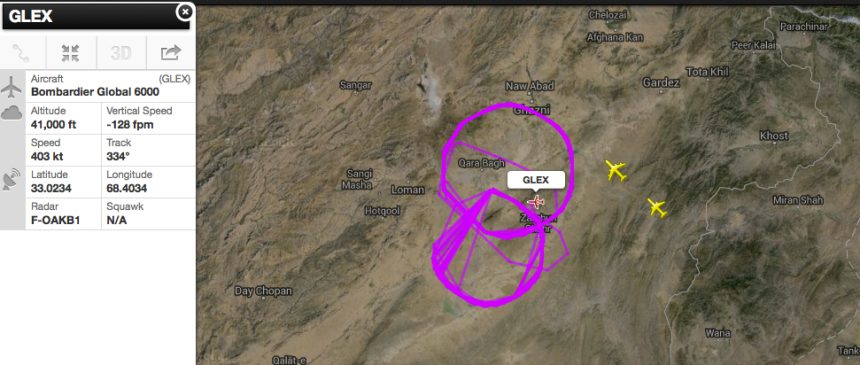At least seven Taliban militants were killed following a NATO air raid Afghanistan. Noteworthy, a sign of the developing operation may have been a U.S. Air Force E-11A BACN plane orbiting over southeasern Ghazni province, clearly visible on Flightradar24.com.
Although many military aircraft are equipped with Automatic Dependent Surveillance-Broadcast (ADS-B) transponders they are usually turned off during real war operations. In fact, by automatically broadcasting the plane’s callsign, GPS position, speed and altitude, these special transponders provide information about the plane can be received by ground stations, by other nearby aircraft (thus enhancing situational awareness) and also by commercial off-the-shelf or home-built receivers.
Flightradar24 and PlaneFinder have a network of several hundred feeders around the world who make the flight information received by their home kits available for anybody on their websites, or by means of their smartphone apps.
Even though some pilots have confirmed they are well aware of the above mentioned websites and for this reason are instructed to turn off their transponders when involved in real operation, during the opening stages of the Libya Air War, some of the aircraft involved in the air campaign forgot/failed to switch off their mode-S or ADS-B transponder, and were clearly trackable on FR.24 or PF.net.
Three years later, a U.S. plane involved in war mission over Afghanistan could be monitored for several hours as it circled at 41,000 feet to the southeast of Ghazni.
The aircraft did not broadcast its mission callsign, but based on the hex code FR24 could identify it as a Bombardier Global 6000 aircraft, an advanced ultra long-range business jet that has been modified by the U.S. Air Force to accomodate Battlefield Airborne Communications Node (BACN) payload.
Within the U.S. Air Force, the modified jet is designated E-11A.
BACN is technological “gateway” system that allows aircraft with incompatible radio systems and datalinks to exchange tactical information and communicate.
By orbiting at high-altitude, BACN equipped air assets provide a communications link from ground commanders to their allies in the sky regardless of the type of the supporting aircraft and in a non-line-of-sight (LOS) environment. In the rugged, mountainous terrain of Afghanistan, troops are not always able to establish LOS communications with close support aircraft overhead and moving position or relocating to higher ground could be fatal. In such situation, a legacy USAF A-10 attack aircraft could loiter away from the battlefield while using the BACN link to communicate with a special-forces Joint Terminal Air Controller (JTAC) on the ground until all targeting information is ready before “un-masking” and beginning an attack run.
The BACN system is also deployed onboard EQ-4B Global Hawk UAVs.
Anyway, the E-11A could be tracked on FR24.com for about 9 hours, from 21.54 UTC on Aug. 10 to 06.45 UTC on Aug. 11, when the aircraft got out of the flightradar24 coverage while returning back to Kandahar airfield (?). At the same time a NATO air strike in the same zone killed seven Taliban and wounded four.
Next time NATO is preparing a similar operation, the presence of the orbiting E-11A could expose and jeopardize the imminent air strike.
H/T to Jerod Harris for the heads-up.
Image credit: screenshot form flightradar24.com
















